Deanna Morse traveled to the 45th annual Ann Arbor Film Festival where Michigan celebrated the work of independent animator Helen Hill.
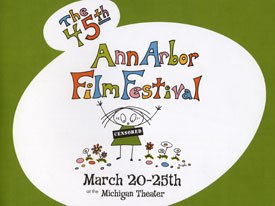
Ann Arbor Film Festival (Michigan) is the oldest experimental film festival in North America. This annual event, held in March, is a weeklong celebration of film form and spirited visual explorations. Though featuring experimental film, animation has had a strong presence over the years. The festival films are edgy, unpredictable, and varied.
Until 2003 the festival screened only film, and some devotees honor the film medium above everything. Discussions of film vs. digital used to seem tiresome to me, but now, they add an interesting layer. When the festival absorbed and adopted video, it did so aggressively; renting high quality projectors to assure that video projection was film-quality.
The festival is held in the beautifully restored Michigan Theater, near the University and downtown Ann Arbor. This classic movie theater provides a rich backdrop for the current avant-garde, and filmmakers often comment on how wonderful it is to see their film screened here, projected on the big screen to an energetic audience. It's a festive event. You enter a sparkly decorated theater lobby, are surprised by the installation artists who are blending in with the décor -- and then enter the 1,700-seat movie palace, decorated with gold leaf where an accomplished organist performs before evening screenings. The 1927 theater organ is lowered into the floor before the films begin to enthusiastic applause.
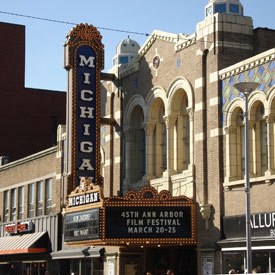
Filmmakers who come to the festival are housed by local residents, and given goodie bags with maps, along with enthusiastic personal greetings from the festival director, Christen McArdle, who somehow knows each one by name. The filmmakers I talked to had only positive things to say about the festival.
Traditionally, the festival has three jurors each year who award more than $15,000-$20,000 in cash. At least one is an animator. Past jurors have included Jules Engel, Christine Panushka, Chel White, Jeffrey Sher, Ann Marie Fleming, Joan Gratz, Jim Duesing and myself.
2007 Ann Arbor Film Festival Dedicated to Helen Hill
This year, the film was dedicated to the memory of animator Helen Hill, a juror at the 42nd festival in 2003. A young and optimistic spirit, she was brutally murdered early this year in her home in New Orleans. Many of her film negatives had been lost in Katrina, along with everything else. Helen had returned to the city, with her family and pet pig, working to re-build the independent film community in that city -- teaching classes and starting a film coop.
Educated at Cal Arts and Harvard, Helen's films were defiantly low-tech. She promoted self-processing, and worked with cutout and merged techniques. In her film Madame Winger Makes a Film: A Survival Guide to the 21st Century, she shows us different sizes of film stocks, and introduces film cameras, demonstrating how easy it is to load a super 8 mm camera. But then, Madame Winger gently reminds us, in her soothing southern accent, that all this high technology isn't really important; to make a film all you really need is a good idea.
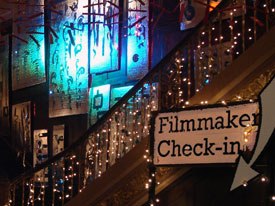
To honor Helen, there was a special afternoon tribute at the Firefly Club, where about 50 folks shared food and drink and their memories of Helen. We sat at small round tables, as Helen's newly remastered film prints were clattering away on a 16mm projector projected on a white sheet. I commented that it was an appropriate venue, something that I think Helen would have wanted and appreciated.
Courtney Egan, a past festival juror and close friend of Helen, encouraged us to go on line and make a donation to a scholarship fund for her 2 year old son.
Funding Controversy: Sexual Content?
Last year, the festival was targeted by a Michigan special interest group (Mackinac Center for Public Policy) in an attempt to cut public funding for all arts. They named films that were deemed pornographic. It was a pretty kooky situation, because several of the named films were selected by their titles only. Things got complicated, political and the festival decided not to accept the rest of its state arts funds. The festival was also told they could not apply for state funding for two more years.
This year, on opening night, Jay Nelson, the president of the board of directors, announced that the festival, supported by the ACLU, was now suing the state of Michigan. As Nelson pointed out, the festival had been an easy target, because they put the film titles on their website. Films were not even screened -- but targeted just because of their titles. Nelson said, "This has all been draining, distracting, and time consuming. We didn't ask for or want this fight. But we see it as our duty as citizens to try to get these restrictions overturned once and for all."

Boobie Girl Named Pornographic Film
This year's animation juror was Brooke Keesling, affectionately introduced as "Brooke: Our Little Pornographer." Her film, Boobie Girl, was one of the named films in the funding flap. Boobie Girl was honored with a Student Academy Award, Student Emmy award and was shown at MOMA this past summer. It's a sweet story, narrated by June Foray (Rocky and Bullwinkle), about a little girl who wishes for big boobs, gets them and then regrets it. Fortunately, she is able to change her wish, and all is well with the world again.
Brooke, a professor in the animation department of the College for Creative Studies in Detroit, says, "To have money pulled from a festival over my film... well it is just completely bonkers."
Michigan Banned Films
Trying to turn this lousy situation into an opportunity, the festival decided to promote free speech. The festival featured a program of Faux Porn, screening many of the titles that were "Banned in Michigan." The festival is selling a DVD of the banned films. More information is on the festival's website.
There were also yummy chocolate bars created especially for the festival, called Censored Bars. They came in light and dark. I can attest. Both were very tasty.
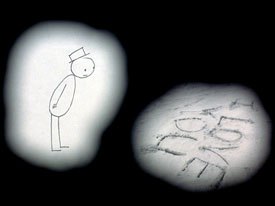
Animated Films in Competition
Out of more than 2,000 entries, about 120 were selected for competition screening, and 25 of these were animations. But this festival does not split films easily into modes or genres. Many of the experimental films also include animated elements. In fact, that is one of the joys of being at Ann Arbor. The festival stretches definitions of approaches -- of animation, of documentary, of experimental films. This festival honors pieces that question traditional cinema language.
For instance, Hair Lady by David Birdsell, an experimental film, has two great sequences of a guy animated (through editing single frames) walking along the street, and of his animated hair growing back. Some would not consider this animation, but it sure is visual fun, a treat to watch.
The animated films receiving awards had a similar spirit of innovation, of pushing technical boundaries.
Don Hertzfeldt took the Lawrence Kasdan Award for Best Narrative Film for Everything Will Be OK. This film combines playful visual experimentation with animation and a very dry narration. Using Hertzfeldt's classic stick-figure style, with different bubbles, or iris spotlights revealing parts of a scene, the film follows the angst of a young man who is having a bad time. The graphic form draws attention to itself, but totally in support of the story of this sad-sack character.
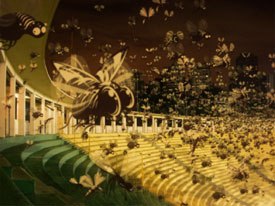
Tyger by Guilherme Marcondes took the award for best animation and included a variety of graphic effects and Noh puppeteers. Inspired by the William Blake poem of the same name, the film merges puppet animation with luminescent neon and the hard-edged cartoon style of a graphic novel. An ecological Godzilla has come to town and is taking back the city. The film can be seen online at http://guilherme.tv/tyger/.
Also screened were two very different animations inspired by Mexico. Suzan's Pitt's surreal narrative El Doctor uses classic cel techniques to tell a very surreal story. Skip Battaglia's Crossing the Stream is a visual play where each cel drawing (frame) is created in a different style, a trademark of Battaglia, but reminiscent of some of the early experiments by Robert Breer.
Another film favorite was Film Noir by Osbert Parker. Paper doll cutouts, created from printouts of old movies were merged with physical objects -- toy cars, hair, a real key, string, slugs. It's very cinematic, with roll focus shots, dramatic lighting and very snappy editing, a tribute to old movies, to cinema and to noir.
A new animator to me was Mike Winkelman. Mike calls his style "instrumental video for instrumental music." He interprets musical soundtracks by breaking them down and assigning visual elements to notes and instruments. IV.6 had hand drawn doodles that were matched with a techno track. Emerging from the center of the screen, they reference Nike sneakers, hot dogs, epidermis, robots. It doesn't seem very deep, but it's sort of fun.
Festival Tour
Many people know the festival through the festival tour, a four-hour program of about 20 films that travels to about 20 cities every year. Programmed with a mix of genres and approaches, the tour gives a taste of what folks enjoy every year for a week at the Michigan Theater in Ann Arbor. Michigan. To book the tour, or see if it is coming near you, go to the film festival's website.
And next year, think about making a trek to Michigan in winter for the Ann Arbor Film Festival. It's a cosmopolitan experience in the middle of the Midwest that will help bend your brain, keep you questioning the nature of film language... and supports free speech!
Deanna Morse is an animator and a professor of film and video in the School of Communications at Grand Valley State University, Michigan. She serves on the advisory board of the Ann Arbor Film Festival, and is a vice president for ASIFA/International, the international animation society. See her award-winning DVD Move-Click-Move. She sings karaoke.







